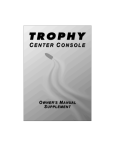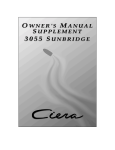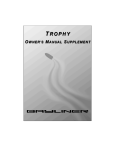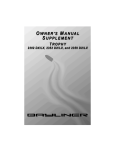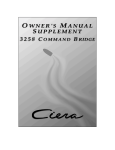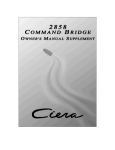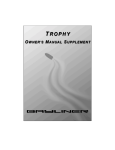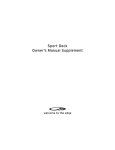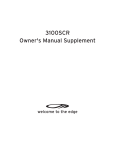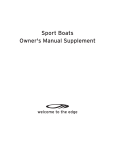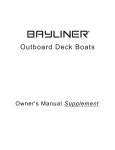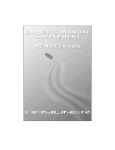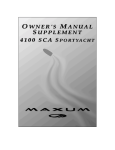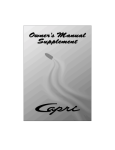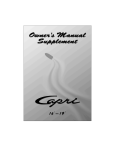Download Bayliner Ciera Owner`s manual
Transcript
The information provided in this Owner’s Manual Supplement
relates to 1999 & 2000 Bayliner Ciera 22' - 28' Cruisers
Engine Serial Number:
Hull Identification Number:
Hull Identification Number
The Hull Identification Number (HIN) is located on the starboard side of the transom. Be sure to record the HIN (and the
engine serial numbers) in the space provided above. Please
refer to the HIN for any correspondence or orders.
HIN LOCATION
(TYPICAL)
© 2000 Bayliner Marine Technical Publications. All rights reserved.
No part of this publication may be reproduced, stored in any retrieval system, or transmitted in any form by any means, electronic, mechanical, photocopying,
recording or otherwise, without prior written permission of Bayliner.
Printed in the United States of America.
General Notes
The material in this document is for information only and is subject to change without notice. While reasonable efforts have been made in the preparation of this
document to assure its accuracy, Bayliner assumes no liability resulting from errors or omissions in this document, or from the use of information contained herein.
Due to our commitment to product improvement, Bayliner reserves the right to make changes in the product design, specifications, and equipment at any
time without notice or obligation. Illustrations and/or photos may show optional equipment.
All Bayliner products meet or exceed USCG (Unites States Coast Guard) and/or NMMA (National Marine Manufacturer’s Association) construction standards.
Manufactured with 1,1,1 Trichloroethane, a substance which harms public health and environment during the manufacturing process by destroying ozone in the
upper atmosphere.
Proprietary Rights
This document discloses subject matter in which Bayliner has proprietary rights. The information and design disclosed herein were originated by and are the property of Bayliner. Neither receipt nor possession thereof confers or transfers any right to reproduce, copy, alter or disclose the document or any part thereof, any
information contained therein, or to construct boats or any item from it, except by written permission from or written agreement with Bayliner. This document is to
be returned upon request to Bayliner.
CONTENTS
Chapter 1: Welcome Aboard
Chapter 2: Components/Systems
1
Dealer Service
6
1
Boating Experience
7
2
Safety Standards
2
Engine & Accessories Guidelines
7
7
2
Qualified Maintenance
3
Structural Limitations
3
Special Care For Moored Boats
3
Sacrificial Anodes (Zincs)
4
Carbon Monoxide (CO)
12 Volt DC System - Fuses and Circuit
Breakers
Battery Charger
Shore Power/110 Volt AC System
9
Fresh Water System
9
Water Heater
9
110-Volt AC/12-Volt DC Refrigerator
10
Alcohol or Alcohol/Electric Stove
10
Air Conditioning (Optional)
11
Navigation and Interior Lights
Carbon Monoxide Alarm System
11
Compass
5
11
Depth Finder
12
Portable toilet
12
Marine Head with Holding Tank
5
5
Electrical System
Sources of CO
What To Do If Carbon Monoxide Is Detected
13
Fuel System
13 Fuel Fills and Vents
13 Anti-siphon Valve
14 Fuel Filters
14
15
Bilge Blower
Bilge Pumps
15 Locations and flow rates of bilge pumps:
15 Bilge Pump Maintenance
16 Autofloat Switch
16
Sleeper Seat Adjustment
16 Fore-aft positions:
16 Lounge positions:
17
Typical Label Locations
Chapter 3: Drawings & Diagrams
18
2252 Express (CP)
21
2355 Express (SJ)
25
2452 Express (CD)
28
2655 Sunbridge (SB)
30
2855 Sunbridge (ST)
33
2858 Command Bridge (EC)
38
2859 Express (SC)
Chapter 4: Wiring Diagrams
45
2252 Express (CP)
46
2355 Sunbridge (SJ)
47
2452 Express (CD)
48
2655 Sunbridge (SB)
49
2855 Sunbridge (ST), Gas Engine
50
2855 Sunbridge (ST), Diesel Engine
51
2858 Command Bridge (EC), Gas Engine
52
2858 Command Bridge (EC), Diesel Engine
53
2859 Express (SC), Gas Engine
54
2859 Express (SC), Diesel Engine
55
Single Dockside Wiring Diagram
56
Double Dockside Wiring Diagram
Limited Warranty
57
What Is Not Covered
57
Other Limitations
57
Your Obligation
Hazard Boxes & Symbols
The hazard boxes and symbols shown below are used throughout this supplement to call attention to potentially dangerous situations which could lead to either personal injury or product damage. Read ALL warnings carefully and
follow all safety instructions.
DANGER!
!
This box alerts you to immediate hazards which WILL cause severe personal injury or death if
the warning is ignored.
!
WARNING!
This box alerts you to hazards or unsafe practices which COULD result in severe personal
injury or death if the warning is ignored.
!
CAUTI ON!
This box alerts you to hazards or unsafe practices which COULD result in minor personal
injury or cause product or property damage if the warning is ignored.
NOTICE
This box calls attention to installation, operation or maintenance information, which is important to proper operation but is not hazard related.
FIRE
HAZARD!
EXPLOSION
HAZARD!
CO POISONING
HAZARD!
ELECTRICAL
HAZARD!
FALLING
HAZARD!
NO OPEN
FLAME!
HOT
HAZARD!
ROTATING
PROPELLER HAZARD!
RUN BILGE BLOWERS
FOR 4 MINUTES!
Ciera 22’ to 28’ Cruisers
•
Owner’s Manual Supplement
Chapter 1: Welcome Aboard
• This Owner’s Manual Supplement was prepared to provide specific information about your boat.
• Study the Cruiser & Yacht Owner’s Manual and this supplement carefully. Pay particular attention to the LIMITED WARRANTY section.
• Keep the Cruiser & Yacht Owner’s Manual and this supplement on your boat in a secure, yet easy to get to place.
Dealer Service
•
•
•
•
•
Ask your dealer to explain all systems before taking delivery of your boat.
Your dealer is your key to service.
Contact your dealer if you have any problems with your new boat.
If your dealer cannot help, call our customer service hotline: 360-435-8957 or send us a FAX: 360-403-4235.
Buy replacement parts from any authorized Bayliner dealer.
Boating Experience
!
WARNING!
CONTROL HAZARD! A qualified operator must be in control of the boat at all times. DO NOT
operate your boat while under the influence of alcohol or drugs.
If this is your first boat or if you are changing to a type of boat you are not familiar with, for your own comfort and
safety, obtain handling and operating experience before assuming command of the boat.
Take one of the boating safety classes offered by the U.S. Power Squadrons or the U.S. Coast Guard Auxiliary. For
more course information, including dates and locations of upcoming classes, contact the organizations directly:
• U.S. Power Squadrons: 1-888-FOR-USPS (1-888-367-8777) or on the Internet at: http://www.usps.org
• U.S. Coast Guard Auxiliary: 1-800-368-5647 or on the Internet at: http://www.cgaux.org
Outside the United States, your selling dealer, national sailing federation or local boat club can advise you of local
sea schools or competent instructors.
1
CHAPTER 1: WELCOME ABOARD
Ciera 22’ to 28’ Cruisers
•
Owner’s Manual Supplement
Safety Standards
DANGER!
DANGER
!
PERSONAL SAFETY HAZARD! DO NOT allow anyone to ride on parts of the
boat not designated for such use. Sitting on seat backs, lounging on the forward
deck, bow riding, gunwale riding or occupying the transom platform while
underway is especially hazardous and will cause personal injury or death.
DANGER!
DANGER
!
PERSONAL SAFETY HAZARD! ALWAYS secure the anchor and other loose objects before getting underway. The anchor and other items that are not properly secured can come loose when
the boat is moving and cause personal injury or death.
Your boat’s mechanical and electrical systems were designed to meet safety standards in effect at the time it was
built. Some of these standards were mandated by law, all of them were designed to insure your safety, and the safety
of other people, vessels and property.
In addition to this owner’s manual supplement, please read the Cruiser & Yacht Owner’s Manual and all accessory instructions for important safety standards and hazard information.
Engine & Accessories Guidelines
NOTICE
When storing your boat please refer to your engine’s operation and maintenance manuals.
Your boat’s engine and accessories were selected to provide optimum performance and service. Installing a different
engine or other accessories may cause unwanted handling characteristics. Should you choose to install a different
engine or to add accessories that will affect the boat’s running trim, have an experienced marine technician perform a
safety inspection and handling test before operating your boat again.
Certain modifications to your boat can result in cancellation of your warranty protection. Always check with
your dealer before making any modifications to your boat.
The engine and accessories installed on your boat come with their own operation and maintenance manuals. Read
and understand these manuals before using the engine and accessories.
Qualified Maintenance
!
WARNING!
To maintain the integrity and safety of your boat, allow only qualified personnel to perform
maintenance on, or in any way modify: The steering system, propulsion system, engine control
system, fuel system, environmental control system, electrical system or navigational system.
Failure to maintain your boat’s systems (listed in the warning above) as designed could violate the laws in your jurisdiction and could expose you and other people to the danger of bodily injury or accidental death. Follow the instructions provided in the Cruiser & Yacht Owner’s Manual, this Owner’s Manual Supplement, the engine owner’s manual
and all accessory instruction sheets and manuals included in your boat’s owner’s packet.
2
Ciera 22’ to 28’ Cruisers
•
Owner’s Manual Supplement
CHAPTER 1: WELCOME ABOARD
Structural Limitations
If equipped, the transom platform and bow platform are designed to be lightweight for proper boat balance. The load
limit for these platforms is 30 pounds per square foot, evenly distributed.
Special Care For Moored Boats
NOTICE
• To help seal the hull bottom and reduce the possibility of gelcoat blistering on moored boats,
apply an epoxy barrier coating, such as INTERLUX, Interprotect 2000E/2001E. The barrier
coating should be covered with several coats of anti-fouling paint.
• Many states regulate the chemical content of bottom paints in order to meet environmental
standards. Check with your local dealer about recommended bottom paints, and about the
laws in effect in your area.
Whether moored in saltwater or freshwater, your boat will collect marine growth on its hull bottom. This will detract
from the boat’s beauty, greatly affect its performance and may damage the gelcoat.
• Periodically haul the boat out of the water and scrub the hull bottom with a bristle brush and a solution of soap
and water.
Sacrificial Anodes (Zincs)
NOTICE
Do not paint between the zinc and the metal surface it contacts and do not paint over the zincs.
Your boat is equipped with sacrificial anodes (zincs) to protect underwater metal parts from excessive deterioration.
Check the zincs regularly and replace them if they have deteriorated more than 70%.
There are many factors that affect the rate at which the zincs deteriorate, including:
• Water temperature
• Salinity
• Water pollution
Stray electrical current from the boat or dock may cause complete deterioration in just a few weeks. If there is rapid
zinc deterioration, measure the electrolytic corrosion around your boat with a Corrosion Test Meter. If the zincs are
not bonded correctly, they will not provide protection.
3
CHAPTER 1: WELCOME ABOARD
Ciera 22’ to 28’ Cruisers
•
Owner’s Manual Supplement
Carbon Monoxide (CO)
!
DANGER!
CARBON MONOXIDE POISONING HAZARD!
DANGER
Carbon monoxide gas (CO) is colorless, odorless, and extremely dangerous. All
engines, generators, and fuel burning appliances produce CO as exhaust. Direct and
prolonged exposure to CO will cause BRAIN DAMAGE or DEATH.
Signs of CO poisoning include:
• Headache
• Nausea
• Dizziness
• Drowsiness
•
•
•
•
CO poisoning causes a significant number of boating deaths each year.
Called the "silent killer", CO is an extremely toxic, colorless, odorless and tasteless gas.
Breathing CO blocks the ability of your blood to carry oxygen.
The effects are cumulative, even low levels of exposure can result in injury or death.
Factors increasing the effects of CO poisoning include:
• Age
• Smokers or people exposed to high concentrations of cigarette smoke
• Consumption of alcohol
• Lung disorders
• Heart problems
• Pregnancy
4
Ciera 22’ to 28’ Cruisers
•
Owner’s Manual Supplement
CHAPTER 1: WELCOME ABOARD
Sources of CO
Sources of CO include:
a. Using engine or generator
when boat is moored in a
confined space.
b. Mooring close to
another boat that
is using its engine,
generator or any
other CO source.
c. Running boat with
trim angle of bow
too high.
d. Running boat without through ventilation (station wagon
effect).
To correct stationary situations (a) and/or (b):
• Close all windows, portlights and hatches.
• If possible, move your boat away from the source of CO.
To correct running situations (c) and/or (d):
• Trim bow down.
• Open windows and canvas.
• When possible, run boat so that prevailing winds will help dissipate exhaust.
Immediately take corrective action if CO is detected or suspected (see, Carbon Monoxide Alarm System, below).
Carbon Monoxide Alarm System
• Your boat features a carbon monoxide (CO) alarm system.
• Do not disconnect the alarm system.
• Read and understand the manufacturer’s instructions for your CO alarm system. If you did not receive an instruction manual, call (800) 383-0269 and one will be mailed to you.
• If your boat is not equipped with a carbon monoxide alarm, consider purchasing one from your dealer or marine
supply store.
What To Do If Carbon Monoxide Is Detected
• Immediately ventilate and evacuate any enclosed spaces that are occupied by people and reset your CO alarm.
• Immediately move anyone showing any symptoms of CO poisoning into fresh air.
• See a doctor if any symptoms persist. If the person is unconscious, immediately administer oxygen or CPR and
call for emergency help.
5
Ciera 22’ to 28’ Cruisers
•
Owner’s Manual Supplement
Chapter 2: Components/Systems
Electrical System
We strongly recommend that you read and understand the Electrical Section of the Owner’s Manual.
!
•
•
•
•
•
DANGER
E X T R E M E F IR E /E X P L O S IO N H A Z A R D !
To minimize the risks of fire and explosion, NEVER install knife switches or other arcing
devices in the fuel compartments.
NEVER substitute automotive parts for marine parts. Electrical, ignition and fuel system
parts were designed and manufactured to comply with rules and regulations that minimize
risks of fire and explosion.
DO NOT modify the electrical systems or relevant drawings.
Only qualified personnel should install batteries and/or perform electrical system
maintenance.
Insure that all battery switches are in the OFF position before performing any work in the
engine spaces.
!
WARNING
F IR E /E X P L O S IO N H A Z A R D !
• Fuel fumes are heavier than air and will collect in the bilge areas where they can be accidently ignited. Visually and by smell (sniff test), check the engine and fuel compartments for
fumes or accumulation of fuel. Operate the bilge blower for at least four minutes prior to
engine starting, electrical system maintenance or activation of electrical devices.
• Minimize the danger of fire and explosion by not exposing batteries to open flame or sparks.
It is also important that no one smoke anywhere near the batteries.
!
CAUTION
S H O C K /E L E C T R IC A L S Y S T E M D A M A G E H A Z A R D !
• Never disconnect the battery cables while the engine is running as this can cause damage to
your boat’s electrical system components.
• The battery charging systems (alternator and, if applicable, battery charger) installed on
your boat are designed to charge conventional lead-acid batteries. Before installing gel-cell
or other new technology batteries, consult with the battery manufacturer about charging
system requirements.
NOTICE
• Electrical connections are susceptible to corrosion. Minimize electrical problems due to corrosion by keeping all exposed electrical connections clean and protected with with a sprayon protectant such as Corrosion Guard®.
• VOLTAGES - All boats use either 110-volt AC/60 Hertz, 240-volt AC/60 Hertz or 220-volt
AC/50 Hertz single phase systems, and 12-volt DC or 24-volt DC. Electrical distribution
panels are labeled with voltage and frequency of AC and DC.
6
Ciera 22’ to 28’ Cruisers
•
Owner’s Manual Supplement
CHAPTER 2: COMPONENTS/SYSTEMS
12 Volt DC System - Fuses and Circuit Breakers
Both the engine and accessory circuits are protected by a large circuit breaker located on the engine. In addition, a
fuse block for branch accessory circuits is located behind the helm panel. Wires are color-coded to indicate which
accessory each fuse services. Some items, such as radios and bilge pumps, may be fused individually at the unit.
Autofloat switches are fused at the battery.
Battery Charger
Your boat may be equipped with a battery charger. Please refer to the manufacturer’s operating instructions included
in the boat’s owner’s packet. The battery charger operates when AC dockside power is connected and the battery
charger circuit breaker is ON. The battery charger will charge batteries regardless of the battery switch position.
!
CAUTION
The battery charger is designed to charge conventional lead-acid batteries. Before installing
gel-cell or other new technology batteries, consult with the battery manufacturer about charging system requirements.
Shore Power/110 Volt AC System
Your boat may be equipped with an AC system. AC systems are energized by dockside shore power. Standard dockside receptacles and cords provided are rated at 30 amps. Since some shore installations do not have 30 amp service,
we recommend the purchase of 15 amp and 20 amp adapters. Note: When 15 amp or 20 amp adapters are used there
will be a corresponding drop in supplied AC power.
!
DANGER
F IR E /E X P L O S IO N /S H O C K H A Z A R D !
• To minimize shock and fire hazard, DO NOT modify electrical systems or relevant
drawings.
• DO NOT alter shore power connectors and use only compatible connectors.
• Only qualified personnel should install batteries and/or perform electrical
system maintenance.
!
CAUTION
S H O C K /E L E C T R IC A L S Y S T E M D A M A G E H A Z A R D !
• Never connect dockside power to your boat outside North America unless you have purchased the International electrical conversion option, which is rated for 220-volt/50 Hertz.
North American systems are rated for 110-volt/60 Hertz power.
• Use double insulated or three-wire protected electrical appliances when possible.
NOTICE
When using shore power, the simultaneous operation of several AC accessories can result in an
overloaded circuit. It may be necessary to turn off one accessory while operating another.
7
CHAPTER 2: COMPONENTS/SYSTEMS
Ciera 22’ to 28’ Cruisers
!
•
Owner’s Manual Supplement
WARNING
F IR E /E X P L O S IO N /S H O C K /E L E C T R IC A L S Y S T E M
DAM AGE HAZARD!
Before connecting to shore power, all breakers and switches on the AC master panel must be in
the OFF position. Always attach the shore power cord to the boat inlet first, then to the dock
connection, thereby avoiding accidental submersion of the “HOT” cord into the water. To disconnect, first remove the dock connection before removing the cord from the boat.
!
WARNING
F IR E /E X P L O S IO N /S H O C K /E L E C T R IC A L S Y S T E M
DAM AGE HAZARD!
Monitor the electrical control panel’s polarity indicators when connecting shore power to your
boat. A GREEN light illuminating after the power cord is plugged into the boat’s external
power receptacle indicates acceptable electrical power in which you may energize the main
breaker switches. A RED light, however, indicates reversed polarity, which could cause electrical system damage and possibly electrical shock injuries. In this case, DO NOT energize the
main breaker switches. Instead, immediately disconnect the shore power cord (always from the
dockside outlet first) and notify marina management.
! CAUTION
WATER HEATER DAMAGE HAZARD! DO NOT energize the AC water
heater electrical circuit until the heater is completely filled with water. Even
momentary operation in a dry tank will damage the heating elements. Warranty replacements will not be made on elements or tank damaged in this
manner. The tank is full if water flows from the tap when the hot water is
turned on in the galley.
TYPICAL
SHORE POWER
RECEPTACLE
MASTER BREAKERS
TYPICAL AC
POWER PANEL
8
On boats with a single dockside inlet, check for proper
polarity as outlined in the previous warning. Activate the
AC system by first turning on
the master breaker, then each
individual component breaker
as required.
On boats with dual dockside
inlets, check for proper polarity as outlined in the previous
warning. Each dockside inlet
is labeled inside the weatherproof cover, line 1 or line 2,
which corresponds to the line
each operates on the AC master panel. This system is
designed so that each line
operates independent of each
other. Activate the AC system
by first turning on the master
breakers, then each individual
component as required.
Ciera 22’ to 28’ Cruisers
•
Owner’s Manual Supplement
CHAPTER 2: COMPONENTS/SYSTEMS
Fresh Water System
Fresh water systems are available on some models. These pressure-type (demand) systems operate when the water
pump switch (located near the sink in the cuddy cabin) is in the ON position. Turn the pump switch OFF when the
boat is not in use and when the water tank is empty.
Stored water can become stagnant and distasteful. Pump the water tank dry before leaving your boat unattended for
long periods of time. Occasionally you may want to disinfect your water system. Ask your selling dealer about available treatments and procedures.
Your boat may be equipped with a shower. Please read and follow the manufacturer’s operating instructions supplied
in the owner’s packet.
Water Heater
Your boat may come equipped with a water heater. Be sure to refer to the manufacturer’s operating instructions supplied in the owner’s packet. The water heater is connected to the AC power system. If your boat is equipped with
optional freshwater engine cooling, the coolant from the closed engine cooling system may be circulated through the
hot water tank for heating of potable water.
!
CAUTION
WATER HEATER DAMAGE HAZARD! DO NOT energize the AC water heater electrical circuit until the heater is completely filled with water. Even momentary operation in a dry tank
will damage the heating elements. Warranty replacements will not be made on elements or tank
damaged in this manner. The tank is full if water flows from the tap when the hot water is
turned on in the galley.
110-Volt AC/12-Volt DC Refrigerator
Your boat may come equipped with a 110-volt AC/12-volt DC refrigerator. Please refer to the manufacturer’s instructions included in the boat’s owner’s packet.The refrigerator operates on 110-volt AC and 12-volt DC power. When
the 110-volt AC system is not hooked up to an AC source, the refrigerator operates on 12-volts DC. When a 110-volt
AC source is supplied by dockside power and the AC refrigerator breaker is ON, the refrigerator automatically
switches to 110-volt AC.
NOTICE
The refrigerator has the heaviest continuous draw on the 12-volt system. In less than 24 hours,
the refrigerator can render a 100-amp battery useless for engine starting. For this reason, it is
recommended that when operating on 12-volts, the cold setting on the refrigerator should not
be set higher than position two (2). It is also advisable to turn off your refrigerator at night or
when not in use. If you are going to be out for more than one day and cannot connect to dockside power, you should plan to run the engine each day to maintain a charged battery.
9
CHAPTER 2: COMPONENTS/SYSTEMS
Ciera 22’ to 28’ Cruisers
•
Owner’s Manual Supplement
Alcohol or Alcohol/Electric Stove
Operating instructions for the alcohol or alcohol/electric stove can be found in the boat’s owner’s packet. Carefully
read and follow the manufacturer’s operating instructions and warnings before using the stove.
!
WARNING
FIRE HAZARD - Reduce the possibility of fire by removing all combustible materials away
from the stove before/during use.
!
WARNING
FIRE/PERSONAL INJURY HAZARD - Before each use of the 2858 (EC) galley stove, the lower
helm seat’s back rest MUST be lowered into the counter top position to reduce the possibility of
fire or injury (see drawing below).
2858 (EC) GALLEY
HELM SEAT; RAISED IN
BACK REST POSITION
LOWER
HELM
STOVE
HELM SEAT
LOWERED IN
COUNTER TOP
POSITION
Air Conditioning (Optional)
Your boat may be equipped with an optional air conditioning system. Please refer to the manufacturer’s operating
instructions included in your boat’s owner’s packet.
10
Ciera 22’ to 28’ Cruisers
•
Owner’s Manual Supplement
CHAPTER 2: COMPONENTS/SYSTEMS
Navigation and Interior Lights
We strongly recommend that you understand navigation light usage by reading the navigation section of the Owner’s
Manual. The navigation and interior lights supplied with your boat are of top quality, but you should be aware that
failure may periodically occur for a variety of reasons:
1.
2.
3.
4.
There may be a blown fuse (Replace the fuse in the switch panel).
The bulb may be burned out (Carry spare bulbs for replacement).
The bulb base may be corroded (Clean the base periodically and coat it with non-conductive grease).
A wire may have come loose or may be damaged (Repair as required).
!
CAUTION
• Avoid the storage of gear where it would block navigation lights from view.
• Prolonged operation of cabin interior lights (overnight) will result in a drained battery. Be
conservative in the use of battery power.
Compass
Your boat may come equipped with a compass. Carefully read and follow the manufacturer’s calibration and operating instructions provided in the boat’s owner’s packet.
Depth Finder
Your boat may come equipped with a depth finder. It will provide you with measurements of water depth beneath the
boat. In many cases it may help you locate schools of fish. We suggest that you read the manufacturer’s owner’s
operating instructions included in the boat’s owner’s packet before using the unit.
!
WARNING
DO NOT use the depth finder as a navigational aid to prevent collision, grounding, boat damage or personal injury. When the boat is moving, submerged objects will not be seen until they
are already under the boat. Bottom depths may change too quickly to allow time for the boat
operator to react. If you suspect shallow water or submerged objects, operate the boat at very
slow speeds.
11
CHAPTER 2: COMPONENTS/SYSTEMS
Ciera 22’ to 28’ Cruisers
•
Owner’s Manual Supplement
Portable toilet
Your boat may come equipped with a portable toilet. Be sure to read and carefully follow the manufacturer’s operating instructions included in your boat’s owner’s packet.
Marine Head with Holding Tank
Your boat may come equipped with with a marine head and holding tank. Be sure to follow the manufacturer’s operating instructions included in the boat’s owner’s packet.
Seawater is used to flush waste from the toilet into the holding tank. The holding tank is plumbed to a waste fitting on
the deck for use at a dockside pump-out station, and to a macerator pump so that waste may be pumped overboard
(where regulations permit). The switch for the macerator is usually located at the helm station.
If at any time you are unable to pump water into the bowl, the probable cause is debris in the pump diaphragm. To
remedy this, shut the inlet seacock and dismantle the pump. The pump is generally held together with six screws. The
design is simple and the problem will be obvious when the pump body is split open.
To winterize the toilet, shut off the intake valve and pump until the bowl is dry. Remove the drain plug in the base and
pump again to remove all water. Do not fill the bowl with antifreeze. The inlet seacock should be left closed while the
boat is underway, or whenever the boat is left moored in the water.
12
Ciera 22’ to 28’ Cruisers
•
Owner’s Manual Supplement
CHAPTER 2: COMPONENTS/SYSTEMS
Fuel System
!
WARNING
FIRE/EXPLOSION HAZARD - It is very important that the fuel system be
inspected thoroughly the first time it is filled and at each subsequent filling. For
your safety and the safety of your passengers, the fueling instructions in the
Owner’s Manual must be carefully followed.
NOTICE
Air in the diesel supply system (if equipped) can stop an engine or severely restrict performance. If you suspect air in your diesel fuel lines, refer to your engine owner’s manual for
detailed instructions on how to “bleed” the system.
!
CAUTION
Avoid the storage or handling of gear near the fuel lines, fittings and tank.
Fuel Fills and Vents
Fuel fills are located either on the aft deck or on the side decks adjacent to the aft cockpit. Fuel receptacle caps are
marked “Diesel” or “GAS”. Fuel vents are normally located in the hull or transom below and in the same general area
as the fill. If you experience difficulty filling the fuel tank, check to see that the fuel fill and vent lines are free of
obstructions and kinks.
Anti-siphon Valve
Your boat may be equipped with an anti-siphon valve, which is an integral part of the barb fitting on the fuel tank in
which the neoprene fuel line attaches. The valve is spring loaded and is opened by fuel pump vacuum. These valves
will prevent fuel from siphoning from the tank in the event of a fuel line rupture.
NOTICE
If an engine running problem is diagnosed as fuel starvation, check the anti-siphon valve. In the
event the valve is stuck or clogged, it should be changed or replaced while the engine is shut down.
Under NO circumstances should the anti-siphon valve be removed, except in an emergency.
13
CHAPTER 2: COMPONENTS/SYSTEMS
Ciera 22’ to 28’ Cruisers
•
Owner’s Manual Supplement
Fuel Filters
All tanks are equipped with a fine mesh screen filter on the fuel pickup tube (located inside or on the outside of the
tank) to the fuel line fitting. In addition, when supplied by the engine manufacturer, and additional filter is installed
on the engine. Fuel filters should be replaced periodically to ensure they remain clean and free of debris. Consult
your selling dealer or local marina concerning fuel additives that help to prevent fungus or buildup in your fuel tanks.
FUEL TANK
TYPICAL GAS FUEL SYSTEM
FUEL FEED
HOSE
TYPICAL DIESEL FUEL SYSTEM
DECK FITTING,
FUEL FILL
FUEL FILL
DECK FITTING
FUEL
TANK
VENT
FUEL
FILTER
FUEL TANK VENT
FUEL
PICKUP
FUEL
RETURN
FUEL
TANK
Bilge Blower
The bilge blower removes fumes
from the engine compartment and
draws fresh air into the compartment
through the deck vents. To ensure
fresh air circulation, operate the bilge
blower for at least four minutes
before starting the engine, during
starting, and while operating the boat
below cruising speed.
TYPICAL BILGE
BLOWER SYSTEM
!
WARNING
Operation of the blower system is NOT A GUARANTEE that explosive fumes have
been removed. If you smell any fuel, DO NOT start the engine. If the engine is
already running, immediately shut off the engine and all electrical accessories.
Investigate immediately. DO NOT obstruct or modify the ventilation system.
14
Ciera 22’ to 28’ Cruisers
•
Owner’s Manual Supplement
CHAPTER 2: COMPONENTS/SYSTEMS
Bilge Pumps
Your boat is equipped with two impeller-type bilge pumps. They are controlled by a switch on the dash panel, which
should be activated whenever water begins to accumulate in the bilge. Some models will also have an automatic bilge
pump switch (“autofloat switch”), mounted next to the bilge pump. This is a float-type switch that will activate a
bilge pump automatically whenever the bilge water accumulates above a pre-set level. It is wired directly to the battery so it will normally function even when the boat is completely shut down and unattended, such as when the boat
is moored at a marina.
Locations and flow rates of bilge pumps:
Model
Aft
(8.3 gpm)
2252 (CP)
2355 (SJ)
Aft
(20.83 gpm)
Fwd
(8.3 gpm)
✔
✔
✔
✔
2452 (CD)
✔
✔
2655 (SB)
✔
✔
2585 (EC)
✔
✔
2859 (SC)
✔
✔
Bilge Pump Maintenance
Bilge pumps should be checked often to verify that they
are working properly. To check a bilge pump’s operation,
activate the dash-mounted switch. Verify that water in the
bilge is pumped overboard. If bilge water is present and
the pump motor is running but not pumping, inspect the
discharge hose for a kink or collapsed area. If no problems are found, check the bilge pump housing for clogging debris:
TAB
FIN
FIG. 1
To remove the power cartridge:
1.
Lift the tab while rotating the fins counter-clockwise
and lift out the power cartridge (Fig. 1).
2. Clear the housing of debris.
LIGHT FILM
“O” RING
OF OIL
POWER
CARTRIDGE
FIG. 2
To reinstall the power cartridge:
1. Make sure the “O” ring is properly located and coat
the “O” ring with a light film of vegetable oil or mineral oil (Fig. 2).
2. Align the two cams on either side of the power cartridge with the two slots on the outer housing. Press
the power cartridge into the housing and twist clockwise. Ensure proper reinstallation by attempting to
twist the fins counter-clockwise without lifting the
tab. The cartridge should stay in place.
OUTER
HOUSING
15
CHAPTER 2: COMPONENTS/SYSTEMS
Ciera 22’ to 28’ Cruisers
•
Owner’s Manual Supplement
Autofloat Switch
If applicable, the autofloat switch
should also be checked often for
proper operation. Lift the float by
turning the plastic insert where the
wires enter the housing, 1/4 turn
counter-clockwise (Fig. 3).
As the float is lifted, the bilge
pump should turn on. If lifting the
float does not turn the pump on,
check the inline fuse. If the fuse is
good but the switch does not work,
it may indicate a bad switch or possibly a low battery
.
TYPICAL FLOAT SWITCH
FLOAT
DETAIL
FIG. 3
FLOAT
PLASTIC
INSERT
ON POSITION (UP)
OFF POSITION (DOWN)
NOTICE
Discharge of oil, oil waste or fuel into navigable waters is prohibited by law. Violators are
subject to legal action by the local authorities.
Sleeper Seat Adjustment
Your boat may be equipped with adjustable sleeper seats. These seats can be adjusted fore and aft in the upright position. The seat bottoms of these models also adjust into backrests while the seats are in the lounge position.
Fore-aft positions:
To slide a seat forward or backward, lift up on the front edge of the seat bottom
(A). Move the seat forward until the locking mechanism engages in one of the
three different positions. Lift the aft seat at point (B) and slide the aft seat
towards the forward seat.
Lounge positions:
1. To put the seat into the lounge position, lift up on the front edge of the seat
(A) and pull the seat all the way forward. Lift the aft seat at (B) and pull the
aft seat away from the forward seat until the seat is laid out flat.
2. Lift up on the forward or aft seat bottom at point (C) until the seat bottom
drops into the locked position.
3. To lower the seat bottom, lift the seat at points (C) and (D) at the same time.
Drop the seat bottom flat while holding the seat up at point (D).
4. To return the seat to the operating position, lift the seat back at point (E) and
push the seat bottom toward the center of the seat until it locks into place.
16
Ciera 22’ to 28’ Cruisers
•
Owner’s Manual Supplement
CHAPTER 2: COMPONENTS/SYSTEMS
Typical Label Locations
WINDSHIELD CLOSED LABEL
STEP
WARNING
LABEL
CAPACITY
LABEL
CARBON MONOXIDE
POISON LABEL
SUNLOUNGE
WARNING
MARINE
CORE
USM THANKS/
5YEAR/NMMA
BOARDING
WARNING
FUEL WARNING
DO NOT STEP LABELS
POTABLE
WATER
LABEL
BATTERY
LOCATION
TRANSOM
17
Ciera 22’ to 28’ Cruisers
•
Owner’s Manual Supplement
Chapter 3: Drawings & Diagram s
2252 Express (CP)
Layout View
Overall
Length
Bridge
Clearance
Beam
Maximum
Draft
Fuel Tank
Capacity (gal)
Water Tank
Capacity (gal)
22’ 3”
6’ 6”
8’ 1”
2’ 10”
55
13
Hull Exterior Hardware
FISHBOX
DRAIN
STARBOARD HULLSIDE
ANCHOR
LOCKER
DRAIN
AFT BILGE
PUMP DRAIN
BOW EYE
WASTE TANK VENT
WATER TANK VENT
PORT HULLSIDE
BOW
EYE
GALLEY
DRAIN
FWD BILGE
DRAIN
WASTE OVER
DRAIN (OPTION)
FUEL TANK VENT
STERN EYES
(TYPICAL PORT/STBD)
DECK DRAINS
(TYPICAL PORT/STBD)
TRANSOM
VIEW
GARBOARD
DRAIN
TRIM TAB
(TYPICAL PORT/STBD)
18
Ciera 22’ to 28’ Cruisers
•
Owner’s Manual Supplement
CHAPTER 3: DRAWINGS & DIAGRAMS
Electrical Routing
HULL ELECTRICAL ROUTING
AFT BILGE PUMP
& FLOAT SWITCH
GROUND
FUEL TANK
PLUG
FRESH WATER PUMP
MACERATOR PUMP
GROUND
BLOWER
DECK ELECTRICAL ROUTING
FWD BILGE
PUMP
HARD TOP
OPTION PLUG
FUEL FILL
BONDING
WIRE
SHIFTER
FWD BILGE
PLUG
MARINE
HEAD LIGHT
HORN
SPEAKERS
STERN
LIGHT
DASH
{
WIPER
BOW
LIGHTS
AFT BILGE
ENGINE
LIGHTS
TRIM
PUMP
Fresh Water System
TO WATER FILL
DECK FITTING
TO TANK VENT
THRU-HULL
TO GALLEY
FAUCET
FRESH
WATER
TANK
INLINE PUMP
STRAINER
WATER
PUMP
19
CHAPTER 3: DRAWINGS & DIAGRAMS
Ciera 22’ to 28’ Cruisers
•
Owner’s Manual Supplement
Galley Drain System
SINK
THRU-HULL
DRAIN
HOSE
Marine Head (Option)
WASTE
DECK
FITTING
TO
THRU-HULL
TANK VENT THRU-HULL
MACERATOR
MACERATOR
PANEL
HOLDING
TANK
WASTE
HOSE
HEAD PICKUP
SEACOCK
VALVE
HEAD TO
HOLDING
TANK
MARINE
HEAD
PICKUP TO
MARINE HEAD
20
Ciera 22’ to 28’ Cruisers
•
Owner’s Manual Supplement
CHAPTER 3: DRAWINGS & DIAGRAMS
2355 Express (SJ)
Layout View
Overall
Length
Bridge Clearance
Beam
Maximum
Draft
Fuel Tank
Capacity (gal)
Water Tank
Capacity (gal)
23’ 4”
6’ 2”
8’ 6”
2’ 10”
55
13
Hull Exterior Hardware
FUEL TANK
VENT
AFT BILGE
PUMP DRAIN
OPTIONAL
HOLDING
TANK VENT
WATER
TANK
VENT
FWD BILGE
PUMP DRAIN
ANCHOR
LOCKER
DRAIN
STARBOARD HULLSIDE
OPTIONAL
MACERATOR
PUMP DRAIN
BOW
EYE
STEP
DRAINS
COCKPIT
DRAINS
PORT HULLSIDE
BOW EYE
SINK DRAIN
COCKPIT
DRAINS
TRANSOM VIEW
TRIM TAB
(TYPICAL PORT/STBD)
STERN EYE
(TYPICAL PORT/STBD)
GARBOARD DRAIN
21
CHAPTER 3: DRAWINGS & DIAGRAMS
Ciera 22’ to 28’ Cruisers
•
Owner’s Manual Supplement
Electrical Routing
DECK ELECTRICAL ROUTING (UNDERSIDE VIEW OF DECK)
CABIN LIGHTS
(TYPICAL)
WINDLASS
TOGGLE
SWITCH
ENTRY
STEP
LIGHT
AFT
SPEAKER
BERTH
LIGHTS
WINDLASS
MAIN SWITCH
SPEAKERS
WINDLASS
CIRCUIT
BREAKER
BOW
LIGHT
STERN
LIGHT
HORN
TO WINDLASS
RELAY & DECK
SWITCHES
WIPER
MOTOR
BLOWER
TRIM TAB
PUMP
WIRE PLUG
TO ENGINE
COMPASS
HEAD
LIGHT
SPEAKER
SHIFTER
WASTE
SWITCH
AFT BILGE AREA
WIRE
HARNESS
COCKPIT
STEP LIGHT
AFT BILGE AREA
WINDLASS
BREAKER
(OPTION)
BATTERY
CHARGER
(OPTION)
TO WATER
HEATER
(OPT)
ST
WIRE TO
MACERATOR
PUMP(OPT)
BD
ST
BD
WIRE TO
BILGE PUMP
TILT PUMP
FWD BILGE AREA
AFT
WIRE TO
GALLEY
PORT
WIRE TO
DASH ASSY
GALLEY BACKSIDE
LIGHT
SWITCHES
CASSETTE
STEREO
MASTER CIRCUIT
BREAKER PANEL
WIRE TO
FLOAT SWITCH
V-BERTH
OUTLET
WIRE TO
BILGE PUMP
WIRE TO
HEAD PICK UP
STOVE
WIRES
STOVE
JUNCTION
BOX
REFRIGERATOR
JUNCTION BOX
22
SPEAKER
SELECTOR
SWITCH
Ciera 22’ to 28’ Cruisers
•
Owner’s Manual Supplement
CHAPTER 3: DRAWINGS & DIAGRAMS
Fresh Water System Option
PORT HULLSIDE
GALLEY BACKSIDE
TO COLD WATER
FAUCET
TO HOT WATER
FAUCET (OPTION)
AFT
PORT
TO GALLEY
TO TRANSOM
SHOWER
TO THRU-HULL
WATER
HEATER
FROM SINK DRAIN
AFT BILGE & STARBOARD HULLSIDE
WATER
HEATER
TO TANK FILL
DECK FITTING
WATER PUMP
TO TANK VENT
DECK FITTING
TRANSOM
FRESH WATER
TANK
Waste System Option
FWD
STBD
TO DOCKSIDE PUMP-OUT
DECK FITTING
MARINE HEAD
PICKUP SEACOCK
FWD BILGE
PUMP
SYSTEM
PORT
AFT
HEAD
PICKUP HOSE
FROM
MARINE
HEAD
TO MARINE HEAD
TO TANK VENT
THRU-HULL
TO
THRU-HULL
HOLDING TANK
MACERATOR
PUMP
TO THRU-HULL
TRANSOM
23
CHAPTER 3: DRAWINGS & DIAGRAMS
Ciera 22’ to 28’ Cruisers
•
Owner’s Manual Supplement
Air Conditioning Option
PICKUP
SEACOCK
SEA WATER
STRAINER
A/C WATER
PUMP
A/C
CONTROL
PANEL
AFT BERTH
A/C
VENT
DRAIN
INTO
BILGE
A/C
VENT
A/C UNIT
ENTRY
STEPS
TO THRUHULL DRAIN
TO DOCKSIDE
A/C PANEL
PUMP JUNCTION
WALL BOX
A/C
DUCT
A/C UNIT
24
Ciera 22’ to 28’ Cruisers
•
Owner’s Manual Supplement
CHAPTER 3: DRAWINGS & DIAGRAMS
2452 Express (CD)
Layout View
Overall
Length
Bridge
Clearance
Beam
Maximum
Draft
Fuel Tank
Capacity (gal)
Water Tank
Capacity (gal)
Holding Tank
Capacity (gal)
23’ 5”
8’ 4”
8’ 4”
2’ 11”
78
20
78
Hull Exterior Hardware
FWD BILGE
PUMP DRAIN
AFT BILGE
PUMP DRAIN
WATER TANK VENT
A/C DRAIN
(OPTION)
CLAM SHELL
OVER ANCHOR
LOCKER DRAIN
STARBOARD HULLSIDE
FISHBOX
DRAIN
SINK DRAIN
BOW
EYE
WASTE TANK VENT
MACERATOR DRAIN
PORT HULLSIDE
TRANSOM
VIEW
STERN EYE
(TYPICAL PORT/STBD)
FUEL VENT
DECK DRAINS
(TYPICAL PORT/STBD)
TRIM TAB
(TYPICAL PORT/STBD)
MACERATOR
DISCHARGE
GARBOARD
DRAIN
Air Conditioning Option
SEAWATER
PICKUP STRAINER
SEACOCK
A/C
UNIT
SEAWATER
PICKUP PUMP
TO A/C VENTS
PORT
FWD
AFT
STBD
A/C
UNIT
TO THRUHULL DRAIN
25
CHAPTER 3: DRAWINGS & DIAGRAMS
Ciera 22’ to 28’ Cruisers
•
Owner’s Manual Supplement
Electrical Routing
DECK ELECTRICAL ROUTING
DASH HARNESS
DINETTE LIGHTS
STEREO
FUSE BLOCK
LOCATION
V-BERTH
LIGHT
HARD TOP
WIPERS
DINETTE LIGHT
HEAD LIGHT
CABIN
GALLEY LIGHTS
SPEAKERS
HARDTOP ELECTRICAL ROUTING
DASH
CONNECTION
LIGHTS
ANCHOR
LIGHT
Macerator Option
MACERATOR
PUMP
MARINE HEAD
TO WASTE TANK
STBD
AFT
WASTE
HOLDING
TANK
WASTE TANK
TO MACERATOR
TO PUMP OUT
DECK FITTING
26
TO OVERBOARD
THRU-HULL
HORN
BOW
LIGHT
Ciera 22’ to 28’ Cruisers
•
Owner’s Manual Supplement
CHAPTER 3: DRAWINGS & DIAGRAMS
Fresh Water/Marine Head System
PORT
FWD SIDE OF
BULKHEAD VIEW
HEAD PICKUP
SEACOCK
TO FAUCET
HEAD TO
WASTE TANK
FWD
BILGE
PUMP
FWD
FRESH WATER
TANK TO FAUCET
AFT
MARINE
HEAD
STBD
MARINE
MARINE HEAD
HEAD
TO
TO WASTE
WASTE TANK
TANK
WATER TANK VENT
THRU-HULL FITTING
WATER TANK
VENT HOSE
WASTE
HOLDING
TANK
FWD BILGE PUMP
THRU-HULL DRAIN
FRESH
WATER
TANK
FROM DECK
WATER FILL
FITTING
Hot Water System Option
TO TRANSOM
SHOWER
WATER
HEATER
TO FAUCET
HEATED
WATER
WASTE
HOLDING
TANK
WATER TANK TO
WATER HEATER
FRESH
WATER
TANK
WATER
PUMP
27
CHAPTER 3: DRAWINGS & DIAGRAMS
•
Ciera 22’ to 28’ Cruisers
Owner’s Manual Supplement
2655 Sunbridge (SB)
Layout View
Overall
Length
Bridge
Clearance
Beam
Maximum
Draft
Fuel Tank
Capacity (gal)
Water Tank
Capacity (gal)
Holding Tank
Capacity (gal)
27’ 9”
7’ 0”
8’ 5”
2’ 10”
70
27
13
Hull Exterior Hardware
AFT
BILGE
DRAIN
FUEL TANK
VENT
HOLDING
TANK VENT
FWD BILGE
DRAIN
WATER TANK
VENT
SINK
DRAIN
ANCHOR
LOCKER
DRAIN
STARBOARD HULLSIDE
MACERATOR
PUMP DRAIN
STEP DRAIN
SHOWER DRAIN
BOW EYE
TRANSOM VIEW
DECK DRAINS
TYP. PORT/STBD)
TRIM TAB
TYP. PORT/STBD)
STERN EYE
TYPICAL PORT/STBD)
GARBOARD
DRAIN
Hull Electrical Routing
AFT
BLOWER
BLOWER
HOSE
WINDLASS
BREAKER
(OPTION)
BATTERY
SWITCH
FUEL
TANK
TO
GALLEY
TRIM
TABS
FWD
BILGE
PUMP
FLOAT
SWITCH
FWD
TO WATER
PUMPS
STBD
BATTERY
CHARGER
28
TO AFT
BILGE PUMP
AFT
STBD
TO BATTERY
SWITCH
STBD
REFRIGERATOR
12 VOLT
Ciera 22’ to 28’ Cruisers
•
Owner’s Manual Supplement
CHAPTER 3: DRAWINGS & DIAGRAMS
Deck Electrical Routing
GALLEY
LIGHT
SPEAKERS
AFT BERTH
LIGHTS
ENTRY STEP
LIGHT
WINDLASS
CIRCUIT BREAKER
STERN
LIGHT
BOW
LIGHT
HORN
TO DECK
RELAY & WINDLASS
SWITCHES
DOME LIGHTS
WIPER MOTOR
HEAD LIGHT
COMPASS SPEAKERS
WINDLASS
MAIN SWITCH
COCKPIT
STEP LIGHT
Galley Details
SELECTOR SWITCH
DOCK SIDE
PANEL
(OPTION)
STEREO
MICROWAVE
(OPTION)
SINK
STOVE
WATER
PUMP
SWITCH
Marine Head Holding Tank
TO VENT
THRU-HULL
TO DECK
FITTING
MACERATOR
PUMP
TO
MARINE
HEAD
TO
OVERBOARD
DISCHARGE
Deck Fittings and Drains
COCKPIT
DRAINS
FUEL FILL
TRANSOM
SHOWER
(OPTION)
AFT
STBD
WASTE
FITTING
WATER FILL
29
CHAPTER 3: DRAWINGS & DIAGRAMS
Ciera 22’ to 28’ Cruisers
•
Owner’s Manual Supplement
2855 Sunbridge (ST)
Layout View
Overall
Length
Bridge
Clearance
Beam
Maximum
Draft
Fuel Tank
Capacity (gal)
Water Tank
Capacity (gal)
Holding Tank
Capacity (gal)
30’ 3”
7’ 5”
9’ 7”
3’ 1”
109
33
13
Hull Exterior Hardware
WATER
TANK
VENT
FUEL TANK VENT
HOLDING HEAD
TANK
SINK
VENT
DRAIN
MACERATOR
STARBOARD HULLSIDE
COCKPIT
DRAINS
AFT BILGE
PUMP
STEP
DRAIN
FWD BILGE PUMP
SHOWER DRAIN
ANCHOR
DRAIN
A/C
(OPTION)
PORT HULLSIDE
BOW EYE
STERN EYE
COCKPIT
DRAINS
GALLEY SINK
DRAIN
(TYPICAL PORT/STBD)
TRANSOM VIEW
TRIM TAB
(TYPICAL PORT/STBD)
GARBOARD DRAIN
30
Ciera 22’ to 28’ Cruisers
•
Owner’s Manual Supplement
CHAPTER 3: DRAWINGS & DIAGRAMS
Hull Electrical Routing
BATTERY
SWITCH
TRIM TAB
PUMP
FUEL
TANK
TO MACERATOR
PUMP
TO BILGE PUMP
FLOAT SWITCH
TO
ENGINE
TO BATTERY
SWITCH
BLOWER
BATTERY
CHARGER
FWD BILGE WIRE ROUTING
TO
GALLEY
HULL WIRE ROUTING
WINDLASS
BREAKER
(OPTION)
HEAD
OUTLET
TO VANITY
SHOWER
BREAKOUT
TO WATER
PUMP
TO
GALLEY
TO BILGE
PUMP
REFRIGERATOR
12 v & 110V
Deck Electrical System
ENTRY
STEP
LIGHT
GALLEY
LIGHT
AFT BERTH LIGHTS
SPEAKERS
COCKPIT
STEP LIGHT
BOW
LIGHT
HORN
SALON
LIGHTS
WIPER
MOTOR
TO WINDLASS
RELAY & DECK
SWITCHES
DINETTE
LIGHTS
TO WINDLASS
CIRCUIT BREAKER
COMPASS
HEAD
LIGHT
TO WINDLASS
MAIN SWITCH
RADAR
WING
PLUG
31
CHAPTER 3: DRAWINGS & DIAGRAMS
Ciera 22’ to 28’ Cruisers
•
Owner’s Manual Supplement
Helm Area
FUSEBLOCK
WINDLASS
SWITCH
(OPTION)
WASTE PUMP
SWITCH
Air Conditioning System
AIR CONDITIONING
WATER PICKUP
AIR CONDITIONING ROUTING
TO HANGING
LOCKER TOP
TO AFT
STATE ROOM
AC PICKUP
SEACOCK
TO AC UNIT
Freshwater System
TRANSOM
SHOWER
HEAD
HEATER
PUMP
GALLEY
TANK
Marine Head System and Waste Fitting
TO VENT
THRU-HULL
TO DECK
FITTING
WASTE FITTING
MACERATOR
PUMP
TO
MARINE
HEAD
32
DECK
LOUVER
TO
OVERBOARD
DISCHARGE
Ciera 22’ to 28’ Cruisers
•
Owner’s Manual Supplement
CHAPTER 3: DRAWINGS & DIAGRAMS
2858 Command Bridge (EC)
Layout View
Overall
Length
Bridge
Clearance
Beam
Maximum
Draft
Fuel Tank
Capacity (gal)
Water Tank
Capacity (gal)
Holding Tank
Capacity (gal)
30’ 6”
9’ 3”
9’ 10”
3’ 6”
113
34
26
Hull Fittings and Hardware
WATER TANK VENT
AFT BILGE
PUMP DRAIN
STARBOARD HULLSIDE
CLAM SHELL COVER
(ANCHOR WELL DRAIN)
BOW EYE
FWD BILGE
PUMP DRAIN
GALLEY
SINK
DRAIN
HEAD
SINK
DRAIN
SHOWER
SUMP
DRAIN
PORT HULLSIDE
BOW EYE
HOLDING TANK VENT
FUEL TANK VENT
DECK DRAINS
(TYP PORT & STBD)
TRANSOM VIEW
STERN EYES
TRIM TABS
(TYP PORT
& STBD)
MACERATOR
DISHCARGE
GARBOARD
DRAIN
33
CHAPTER 3: DRAWINGS & DIAGRAMS
Ciera 22’ to 28’ Cruisers
•
Owner’s Manual Supplement
12 Volt DC Wire Routing
HULL WIRE ROUTING
WINDLASS
CIRCUIT
BREAKER
BATTERY
TRIM
PUMP
MACERATOR
AFT BILGE
PUMP &
FLOAT
SWITCH
SHOWER
SUMP
HEAD
PICKUP
GROUND
AFT BERTH
LIGHT
FUEL
TANK
SENDER
BATTERY
CHARGER
TRIM
TABS
ENG GRND
COURTESY
LIGHT
STEP
LIGHT
ENGINE
WATER
PUMP
READING
LIGHT
AFT BERTH
READING
LIGHT
FWD BILGE PUMP
& FLOAT SWITCH
LOWER
HELM
LIGHT
SWITCHES
GALLEY WATER
PUMP SWITCH
BLOWER
FUEL FILL
GROUND
BATTERY
SWITCH
TO WINDLASS
DECK SWITCHES
TO WINDLASS
MAIN SWITCH &
HELM REMOTE
SWITCH (OPTION)
FROM WINDLASS
MAIN SWITCH &
HELM REMOTE
SWITCH (OPTION)
TO UPPER HELM
COCKPIT
LIGHTS
PLUG TO
ENG HARNESS
READING
LIGHT
DECK WIRE ROUTING (UNDERSIDE VIEW)
WIPER
STBD
GALLEY
LIGHTS
V - BERTH
OVERHEAD
LIGHT
HORN
BOW
LIGHT
ENTRY
LIGHT
34
MIID BERTH
LIGHT
DINETTE
LIGHTS
HALL
LIGHTS
SPEAKER
WIRES
CENTER &
PORT WIPERS
(OPTION)
TO WINDLASS,
RELAY & DECK
SWITCHES
Ciera 22’ to 28’ Cruisers
•
Owner’s Manual Supplement
CHAPTER 3: DRAWINGS & DIAGRAMS
110 Volt AC Wire Routing (Romex)
BATTERY
CHARGER
HANGING
LOCKER
AFT BERTH
CABINET
WATER
HEATER
MICROWAVE
GALLEY
AC PANEL
STOVE
REFRIGERATOR
GFI FWD
HELM
Fresh Water System
WATER
HEATER
WATER FILL
DECK FITTING
TO HEAD
FAUCET
WATER TANK
VENT THRU-HULL
FITTING
HOT
WATER
TO GALLEY
FAUCET
COLD
WATER
WATER
PUMP
FWD BILGE
PUMP
FRESH
WATER
TANK
STBD
FWD
35
CHAPTER 3: DRAWINGS & DIAGRAMS
Ciera 22’ to 28’ Cruisers
•
Owner’s Manual Supplement
A/C Hose Routing (OAB)
SEAWATER PUMP
AIR COND. UNIT
JUNCTION
TO A/C
UNIT
STBD
SEAWATER
STRAINER
FWD
TRANSOM
SEAWATER PICKUP
& BALL VALVE
PORT
FROM SEAWATER
INTAKE PUMP
Shower Drain System
SHOWER DRAIN
THRU-HULL
TO SHOWER
DRAIN THRU-HULL
SHOWER
DRAIN
ELBOW
SHOWER
SUMP PUMP
STBD
FWD
36
AIR CONDITIONER
DRAIN THRU-HULL
Ciera 22’ to 28’ Cruisers
•
Owner’s Manual Supplement
CHAPTER 3: DRAWINGS & DIAGRAMS
Marine Head System
DOCKSIDE PUMPOUT DECK FITTING
TANK VENT
THRU-HULL
MARINE HEAD
HOLDING TANK
MARINE HEAD TO
HOLDING TANK
MACERATOR
SEAWATER PICKUP
TO MARINE HEAD
MACERATOR
OUTLET THRU-HULL
TRANSOM
HEAD
PICKUP
SEACOCK
Seawater Pickup System (Diesel Engine Option)
TO DIESEL ENGINE
WATER INLET FITTING
TRANSOM
TO GIMBAL HOUSING
WATER INLET FITTING
BALL
VALVE
SEAWATER
STRAINER
37
CHAPTER 3: DRAWINGS & DIAGRAMS
Ciera 22’ to 28’ Cruisers
•
Owner’s Manual Supplement
2859 Express (SC)
Layout View
Overall
Length
Bridge
Clearance
Beam
Maximum
Draft
Fuel Capacity
(gal)
Water Tank
Capacity (gal)
Holding Tank
Capacity (gal)
27’ 8”
9’ 1”
9’ 9”
3’ 0”
102
36
30
Hull Exterior Hardware
AFT BILGE
PUMP DRAIN
FWD BILGE
PUMP DRAIN
HOLDING TANK VENT
STARBOARD HULLSIDE
BOW
EYE
MACERATOR
PUMP OUT COCKPIT STEP
DRAIN
HEAD SINK
DRAIN
GALLEY
SINK
DRAIN
CLAM SHELL
OVER ANCHOR
LOCKER DRAIN
A/C DRAIN
(OPTION)
FUEL VENT
TRANSOM
VIEW
DECK DRAINS
(TYPICAL PORT/STBD)
TRIM TAB
(TYPICAL PORT/STBD)
STERN EYE
(TYPICAL PORT/STBD)
38
GARBOARD
DRAIN
Ciera 22’ to 28’ Cruisers
•
Owner’s Manual Supplement
CHAPTER 3: DRAWINGS & DIAGRAMS
Marine Head System
TANK TO
MACERATOR
TO VENT
THRU-HULL
WATER
HOSE
HOLDING
TANK
HEAD TO
TANK
HEAD TO
HOLDING TANK
DECK WASTE
FITTING
TANK VENT
THRU-HULL
SEACOCK
PICK UP
TO HEAD
SEA
STRAINER
FROM
MACERATOR
TO THRU-HULL
MACERATOR
PUMP
HOLDING TANK
Seawater Pickup System (Diesel Engine Option)
TRANSOM
TO GIMBAL HOUSING
WATER INLET FITTING
TO DIESEL ENGINE
WATER INLET FITTING
SEAWATER
STRAINER
BALL
VALVE
39
CHAPTER 3: DRAWINGS & DIAGRAMS
Ciera 22’ to 28’ Cruisers
•
Owner’s Manual Supplement
Fresh Water System
WATER FILL
DECK FITTING
WATER
HEATER
TANK VENT
HOT FROM
WATER HEATER
HOT TO
HEAD
COLD TO
HEAD
COLD TO
GALLEY
HOT TO
HEAD SINK
TO WATER
HEATER
COLD TO
HEATER
FRESH
WATER
TANK
HOT TO
GALLEY
TO WATER FILL
DECK FITTING
FRESH
WATER
PUMP
TO WATER TANK
VENT THRU-HULL
Cabin Heat
T-FITTING
TEMP
SENSOR
VALVE
TO ENGINE
MANIFOLD
CABIN
HEATER
ENGINE WATER
PUMP
WATER
HEATER
40
•
Ciera 22’ to 28’ Cruisers
Owner’s Manual Supplement
CHAPTER 3: DRAWINGS & DIAGRAMS
Shower Drain System
FROM SHOWER
DRAIN TO PUMP
FROM PUMP
TO THRU-HULL
FILTER
PORT
AFT
STBD
SHOWER
PUMP
FWD
SHOWER
PUMP
Galley Sink Drain
SINK
GALLEY
HOT
GALLEY
COLD
SINK DRAIN
TO THRU-HULL
41
CHAPTER 3: DRAWINGS & DIAGRAMS
Ciera 22’ to 28’ Cruisers
•
Owner’s Manual Supplement
Deck 12 Volt DC Wire Routing
COCKPIT
LIGHT
DASH
INTERIOR LIGHT
(TYPICAL PORT/STBD)
HEAD LIGHT
TO WINDLASS
MAIN SWITCH
INTERIOR
LIGHTS
COMPASS
WIPER
TO WINDLASS
TOGGLE SWITCH
TO BREAKER
& BATTERY
SWITCH
SPEAKER
COMPASS
AFT BERTH
LIGHTS
SPEAKER
INTERIOR
LIGHTS
TO WINDLASS
RELAY &
DECK SWITCHES
AFT BERTH ENTRY LIGHT
Hull 12 Volt DC Wire Harness
FUEL TANK
AFT BILGE
PUMP
ENGINE
42
TO DECK
HARNESS
FWD BILGE
PUMP
REFRIGERATOR
SHOWER
PUMP
Ciera 22’ to 28’ Cruisers
•
Owner’s Manual Supplement
CHAPTER 3: DRAWINGS & DIAGRAMS
Hull 110 Volt AC Harness
REFRIGERATOR
OUTLET
AFT HANGING LOCKER OUTLET
TO BATTERY
CHARGER
HEAD OUTLET
TO GALLEY
TO DECK
Air Conditioning Routing
SEAWATER
PUMP
SEA
STRAINER
VENT TO AFT
BERTH FWD
BULKHEAD
HIGH SPEED
PICK UP AND
SEACOCK VALVE
A/C UNIT
HANGING
LOCKER TOP
43
CHAPTER 3: DRAWINGS & DIAGRAMS
Ciera 22’ to 28’ Cruisers
•
Owner’s Manual Supplement
Helm Area
WINDLASS
TOGGLE
SWITCH
MACERATOR
PANEL
WINDLASS
PANEL
Fuel System
FUEL FILL
DECK FITTING
FUEL VENT
THRU-HULL
FUEL
TANK
44
FUEL FEED
HOSE
Ciera 22’ to 28’ Cruisers
•
Owner’s Manual Supplement
Chapter 4: Wiring Diagrams
Please read the electrical sections included in the Owner’s Manual and this Owner’s Manual Supplement for important safeguards concerning your boat’s electrical system.
2252 Express (CP)
45
CHAPTER 4: WIRING DIAGRAMS
Ciera 22’ to 28’ Cruisers
2355 Sunbridge (SJ)
5A
46
•
Owner’s Manual Supplement
Ciera 22’ to 28’ Cruisers
•
Owner’s Manual Supplement
CHAPTER 4: WIRING DIAGRAMS
2452 Express (CD)
47
CHAPTER 4: WIRING DIAGRAMS
2655 Sunbridge (SB)
48
Ciera 22’ to 28’ Cruisers
•
Owner’s Manual Supplement
Ciera 22’ to 28’ Cruisers
•
Owner’s Manual Supplement
CHAPTER 4: WIRING DIAGRAMS
2855 Sunbridge (ST), Gas Engine
49
CHAPTER 4: WIRING DIAGRAMS
2855 Sunbridge (ST), Diesel Engine
50
Ciera 22’ to 28’ Cruisers
•
Owner’s Manual Supplement
Ciera 22’ to 28’ Cruisers
•
Owner’s Manual Supplement
CHAPTER 4: WIRING DIAGRAMS
2858 Command Bridge (EC), Gas Engine
51
CHAPTER 4: WIRING DIAGRAMS
Ciera 22’ to 28’ Cruisers
TRIM/TAB
SWITCH
2858 Command Bridge (EC), Diesel Engine
52
•
Owner’s Manual Supplement
Ciera 22’ to 28’ Cruisers
•
Owner’s Manual Supplement
CHAPTER 4: WIRING DIAGRAMS
2859 Express (SC), Gas Engine
53
CHAPTER 4: WIRING DIAGRAMS
2859 Express (SC), Diesel Engine
54
Ciera 22’ to 28’ Cruisers
•
Owner’s Manual Supplement
Ciera 22’ to 28’ Cruisers
•
Owner’s Manual Supplement
CHAPTER 4: WIRING DIAGRAMS
Single Dockside Wiring Diagram
55
CHAPTER 4: WIRING DIAGRAMS
Double Dockside Wiring Diagram
56
Ciera 22’ to 28’ Cruisers
•
Owner’s Manual Supplement
Ciera 22’ to 28’ Cruisers
•
Owner’s Manual Supplement
Limited Warranty
Bayliner warrants to the original purchasers of its 1999 and 2000 model boats, purchased from an authorized dealer, operated
under normal, noncommercial use that the selling dealer will: (A) Repair any structural hull defect which occurs within five (5)
years of the date of delivery; and (B) Repair or replace any parts found to be defective in factory material or workmanship within
one (1) year of the date of delivery.
W h a t Is No t C ov er e d
This limited warranty does not apply to:
1. Engines, drive trains, controls, props, batteries, or other equipment or accessories carrying their own individual warranties;
2. Engines, parts or accessories not installed by Bayliner;
3. Plexiglass windscreen breakage; rainwater leakage on runabout models; rainwater leakage through convertible tops; minor
gelcoat discoloration, cracks or crazing or air voids;
4. Hull blisters that form below the waterline;
5. Normal deterioration, i.e. wear, tear, or corrosion of hardware, vinyl, tops, vinyl and fabric upholstery, plastic, metal, wood,
or trim tape;
6. Any Bayliner boat which has been overpowered according to the maximum horsepower specifications on the capacity plate
provided on each Bayliner outboard boat;
7. Any Bayliner boat used for commercial purposes;
8. Any defect caused by failure of the customer to provide reasonable care and maintenance.
Ot h e r L i m it a t io n s
THERE ARE NO OTHER EXPRESS WARRANTIES ON THIS BOAT. TO THE EXTENT ALLOWED BY LAW:
1. ANY IMPLIED WARRANTY OF MERCHANTABILITY OR FITNESS FOR A PARTICULAR PURPOSE IS LIMITED
TO THE DURATION OF ONE YEAR.
2. Neither Bayliner nor the selling dealer shall have any responsibility for loss of use of the boat, loss of time, inconvenience,
commercial loss or consequential damages.
3. Some jurisdictions do not allow limitations on how long any implied warranty lasts, so the above limitation may not apply
to you. Some jurisdictions do not allow the exclusion or limitation of incidental or consequential damages, so the above
limitation or exclusion may not apply to you. This limited warranty gives you specific legal rights, and you may also have
other rights which vary from state to state.
Yo ur O bl ig a t io n
In order to comply with regulations, it is essential that your limited warranty registration card be submitted within 30 days of
delivery of your boat. Return of the limited warranty registration card is a condition precedent to limited warranty coverage.
Before any warranty work is performed, we require that you contact your dealer to request warranty assistance.
YOU MUST GIVE US WRITTEN NOTICE OF YOURWARRANTY CLAIM PRIOR TO THE EXPIRATION OF YOUR
LIMITED WARRANTY AND ALLOW US AN OPPORTUNITY TO RESOLVE THE MATTER.
We require that you return your boat, at your expense, to your selling dealer or, if necessary, to the Bayliner factory. You will be
responsible for all transportation, haulouts and other expenses incurred in returning the boat for warranty service.
Bayliner • 133 Weyerhaeuser Drive • Roseburg, OR 97470 • Phone: 541-464-5882 • FAX: 541-673-0426
57
Owner’s Notes
Owner’s Notes
Owner’s Notes
Part Number 1706166
Bayliner • P.O. Box 9029 • Everett, WA 98206 • 360-435-5571




































































